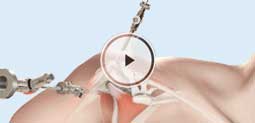Knee
Knee Anatomy
The knee is a complex joint made up of different structures including bones, tendons, ligaments and muscles. They all work together to maintain normal function and provide stability to the knee during movement.
Having a well-functioning healthy knee is essential for our mobility and ability to participate in various activities. Understanding the anatomy of the knee enhances your ability to discuss and choose the right treatment procedure for knee problems with your doctor.
Find out more about Knee Anatomy, click on below tabs.
Arthritis of Knee Joint
Arthritis is a general term covering numerous conditions where the joint surface or cartilage wears out. The joint surface is covered by a smooth articular surface that allows pain free movement in the joint. This surface can wear out for a number of reasons; often the definite cause is not known.
When the articular cartilage wears out the bone ends rub on one another and cause pain. This condition is referred to as Osteoarthritis or wear and tear arthritis as it occurs with aging and use. It is the most common type of arthritis.
Find out more about Arthritis of Knee Joint, click on below tabs.
Meniscus Tear
Meniscus tear is the commonest knee injury in athletes, especially those involved in contact sports. A suddenly bend or twist in your knee cause the meniscus to tear. This is a traumatic meniscus tear. Elderly people are more prone to degenerative meniscal tears as the cartilage wears out and weakens with age. The two wedge-shape cartilage pieces present between the thighbone and the shinbone are called meniscus. They stabilize the knee joint and act as shock absorbers
Find out more about Meniscus Tear, click on below tabs.
Patellofemoral Instability
The knee can be divided into three compartments: patellofemoral, medial and lateral compartment. The patellofemoral compartment is the compartment in the front of the knee between the knee cap and thigh bone. The medial compartment is the area on the inside portion of the knee, and the lateral compartment is the area on the outside portion of the knee joint. Patellofemoral instability means that the patella (kneecap) moves out of its normal pattern of alignment. This malalignment can damage the underlying soft structures such as muscles and ligaments that hold the knee in place.
Find out more about Patellofemoral Instability, click on below tabs.
Arthroscopy of the Knee Joint
Knee Arthroscopy is a common surgical procedure performed using an arthroscope, a viewing instrument, to look into the knee joint to diagnose or treat a knee problem. It is a relatively safe procedure and a majority of the patient's discharge from the hospital on the same day of surgery.
Find out more about Arthroscopy of the Knee Joint, click on below tabs.
Total Knee Replacement (TKR)
Total knee replacement, also called total knee arthroplasty, is a surgical procedure in which the worn out or damaged surfaces of the knee joint are removed and replaced with artificial parts. The knee is made up of the femur (thigh bone), the tibia (shin bone), and patella (kneecap). The meniscus, the soft cartilage between the femur and tibia, serves as a cushion and helps absorb shock during motion. Arthritis (inflammation of the joints), injury, or other diseases of the joint can damage this protective layer of cartilage, causing extreme pain and difficulty in performing daily activities. Your doctor may recommend surgery if non-surgical treatment options have failed to relieve the symptoms.
Find out more about Total Knee Replacement (TKR), click on below tabs.
Anterior Cruciate Ligament ACL Reconstruction
The anterior cruciate ligament is one of the major stabilizing ligaments in the knee. It is a strong rope like structure located in the center of the knee running from the femur to the tibia. When this ligament tears unfortunately, it does not heal and often leads to the feeling of instability in the knee.
Find out more about Anterior Cruciate Ligament ACL Reconstruction, click on below tabs.
ACL Reconstruction Hamstring Tendon
ACL Reconstruction Patellar Tendon
Revision Knee Replacement
Revision knee replacement surgery involves replacing part or all of your previous knee prosthesis with a new prosthesis. Although total knee replacement surgery is successful, sometimes the procedure can fail due to various reasons and require a second revision surgery.
Find out more about Revision Knee Replacement, click on below tabs.
Cartilage Reconstruction
OATS stands for "osteochondral autograft transfer system". It is one of two types of cartilage transfer procedures, the other is called "Mosaicplasty". Cartilage transfer procedures involve moving healthy cartilage from an area of the knee that is non weight bearing to a damaged cartilage area of the knee.
Find out more about Cartilage Reconstruction, click on below tabs.
Meniscus Transplantation
Meniscal transplantation is a surgical procedure to replace the damaged meniscus of the knee with healthy cartilage. The meniscus is a C-shaped cartilage ring that acts like a cushion between the shinbone and the thighbone. Each of your knees has two menisci - one on the inside (medial aspect) and the other on the outside (lateral aspect) of your knee.
Find out more about Meniscus Transplantation, click on below tabs.
Posterior Cruciate Ligament Reconstruction
Posterior cruciate ligament (PCL), one of four major ligaments of the knee, is situated at the back of the knee. It connects the thighbone (femur) to the shinbone (tibia). The PCL limits the backward movement of the shinbone.
Find out more about Posterior Cruciate Ligament, click on below tabs.
Collateral Ligament Reconstruction
Medial collateral ligament (MCL) is one of four major ligaments of the knee that connects the femur (thigh bone) to the tibia (shin bone) and is present on the inside of the knee joint. This ligament helps stabilize the knee. An injury to the MCL may occur as a result of direct impact to the knee.
Find out more about Collateral Ligament Reconstruction, click on below tabs.
Click on the topics below to find out more from the orthopaedic connection website of American Academy of Orthopaedic Surgeons.
- ACL Injury: Should it be fixed?
- Activities After a Knee Replacement
- Adolescent Anterior Knee Pain
- Arthritis of the Knee
- Deep Vein Thrombosis
- Goosefoot (Pes Anserine) Bursitis of the Knee
- Knee Arthroscopy
- Knee Arthroscopy Exercise Guide
- Knee Implants
- Knee Replacement Exercise Guide
- Kneecap (Prepatellar) Bursitis
- Meniscal Tear
- Meniscal Transplants
- Minimally Invasive Total Knee Replacement
- Nonsurgical Treatment Options for Osteoarthritis of the Knee
- Orthopedists Research Female Knee Problems
- Osgood-Schlatter Disease (Knee Pain)
- Osteonecrosis of the Knee
- Posterior Cruciate Ligament (PCL) Tear
- Rotating Platform/Mobile-bearing Knees
- Runner’s Knee (Patellofemoral Pain)
- The Knee
- Total Knee Replacement
- Unstable Kneecap
- Viscosupplementation Treatment for Arthritis












